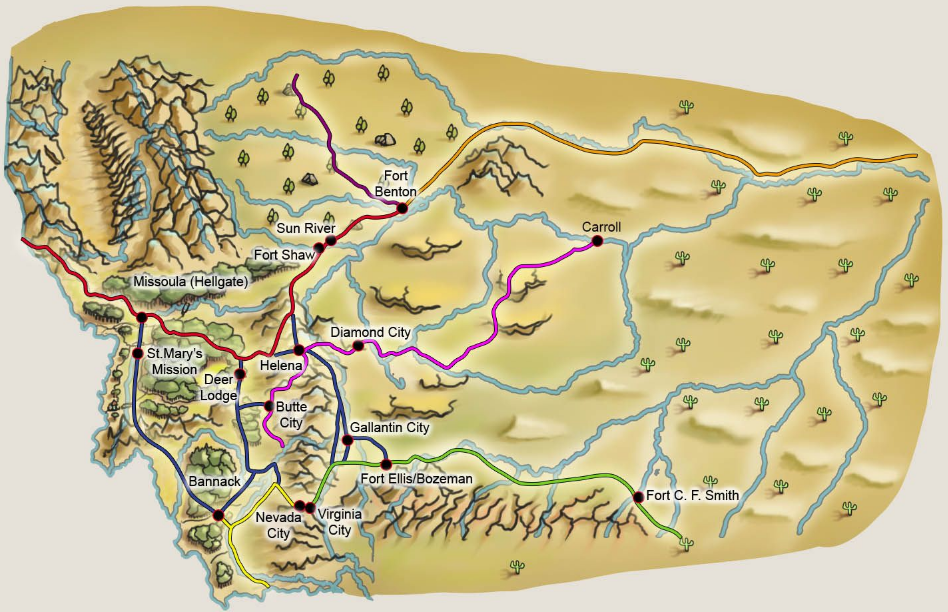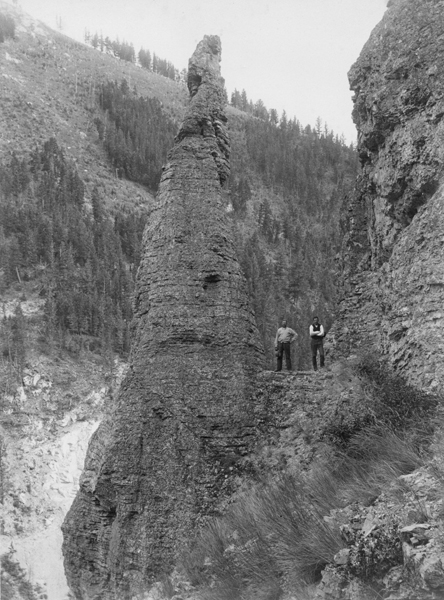I’m thinking of calling it “Soldiers and Statesmen”…what do you think?
Probably not much.
I have a feeling you don’t really care, to be honest.
Remember, 9 copies of the last book sold and 34 of the one before that.
Maybe people don’t care about Montana history in the 20th-century, or maybe they just don’t care about my telling of it.
So I have extremely low expectations for this new Book 6 and that’s why I’m going to just put it out.
I do that with most of my books – you just get tired of tinkering with ‘em and put ‘me out.
I dunno - maybe if I changed the tone of these books to reflect the tone of this blog they'd do better.
Perhaps a blog is a hotter medium than a book, however. I haven't picked up Marshall McLuhan in awhile so we'll just leave it at that.
Hopefully people will read the book...over time. Hey, maybe 30 years from now it'll be a big hit!
I do have to say that a fire was really lit under my ass when I put up a post discussing the book on July 9.
Prior to that I hadn’t touched the book since April. In the last 9 days, however, I’ve added 15,000 words to the book.
There's a lot more to it than just writing, however. You have to organize, put in images, get things in the right spot...make sense of it all.
Here are some highlights of that.
On Mike Mansfield
Mansfield himself was a workhorse, putting in 15-hour days that started at 6:30 AM. Staff arrived at 8 AM and “Mansfield had already read and sorted the mail.” Montana also developed a strong relationship with Vermont at this time, as Mansfield had breakfast nearly every morning with that the green mountain state’s Senator George Aiken.
On JFK
JFK told his secretary the night before his trip to Dallas that LBJ would not be on the ticket in ’64. More, the president had been telling other people in the Democratic Party not to worry about LBJ and his bullying ways, for the man was going to prison. On November 23 a syndicated newspaperman Drew Pearson alleged in a column that LBJ was given a $10,000 bribe for a defense contract.
LBJ was a nobody now, had been ever since Kennedy had tapped him as vice president and even more so after Mansfield had stood by and let the congressional caucus make clear that it did not want LBJ meddling in their business. Worse, LBJ’s corruption was about to be made public. LBJ therefore had the motive, means and opportunity to have Kennedy killed.
The 1966 Montana Senate Race
During the race Babcock “chastised Metcalf for his opposition to America’s expanding roll in the conflict” in Vietnam and called him a “tax and spend” Democrat, one of the earliest uses of that term.
Babcock spent $210,000 in the race to Metcalf’s $68,000. Metcalf “traveled the state in a modest campaign car, spending a relatively small sum on the race.” This was all while Babcock “told Montanans that Metcalf had lost touch with Montana.”
In the end Babcock lost badly. Metcalf took 53% of the vote to the governor’s 47%, or 138,166 votes to 121,697.
The 1968 Democratic National Convention
In August 1968 the Democratic National Convention in Chicago saw several thousand protesters clash with 12,000 police and another 15,000 state and federal officers. Over 500 people were arrested and hundreds of people were injured.
Following the convention Gallup did a poll and found out that 56% of Americans approved of how police had handled the protesters at the convention, with just 31% disapproving. The protesters were vocal and they were active, but the silent majority in the country continued to support those in power.
When the convention ballots were counted, Humphrey won with an overwhelming 1,759 votes to McCarthy’s 601 and McGovern’s 146. Vice President Humphrey would be the nominee, and he’d be facing a former vice president, Richard Nixon.
Montana Farm & Livestock Numbers to 1995
It was estimated that Montana had 3.1 million cattle in January 1976. That sounds like a lot but Texas had 15.6 million cattle. Despite this, Montana was still #14 in the country for cattle and #8 for beef cattle.
The average value of a beef cow in Montana in 1976 was $205. That was low compared to other states, where cattle were more densely packed onto the land. In Vermont, for instance, a cow was worth $345. Dairy had fallen off, however, and Montana was #44 in the nation for milk production in 1976.
There were 635,000 sheep in Montana in 1976 and they had an average worth of $40, which was above the national average of $37.
Beaverhead County had the most cattle in 1995, with 148,000 head. Second was Big Horn County with 128,000 head.
The number of animals, and their value, has fluctuated over the years. In 1960 there were 2.2 million animals with a value of $141 a head. By 1995 that’d shot up to 2.7 million animals with a value of $675 a head.
The real change came in the 1970s. The price per head was $195 but by 1980 it was $510.
Around 30,000 Montanans made their living in the agricultural industry in 1995. Compared to the homesteading days of the 1900s and 1910s, however, the industry’s workers have dropped considerably. In just 70 years about 200,000 fewer people call themselves Montana farmers, ranchers, or just a hired hand in one of the many agricultural pursuits going on around the state.
Rising Medical Costs in America
By the 1990s healthcare costs were double the rate of inflation. In 1990 it was figured that healthcare expenditures were making up 12.2% of the nation’s GDP. That came out to $666.2 billion that year and the average household was spending $2,566 a year on healthcare. A whopping $256 billion was spent on hospital care alone that year. For hospitals, this was great. Their average annual revenue growth had been 14% from 1966 to 1983, and a main reason for that were the exorbitant rates they charged patients.
In 1990 alone there was $10.4 billion in new hospital construction.
Congress tries time and time again to do something but fails miserably. Hospital care funding from the government was 42.5% in 1960 and by 1990 it was 54.7%. To put it another way, $147 was spent per person in 1960 and by 2013 $9,255 was being spent per person. That’s an average annual increase of 8%.
In 1960 businesses, households and private sponsors covered 77% of healthcare costs, with government taking up the other 23%. By 2013 businesses, households and private sponsors were covering 57% of healthcare costs and government was making up the other 43%.
To cover the rising costs of care, patients continually turn to insurance, which has become ever more expensive. Because of this, Americans have managed to keep out-of-pocket hospital costs down. In 1960 they were 21% and by 1980 they got to 5% and have stayed there ever since.
By 1990 Americans were spending $126 billion a year on physician services and another $34 billion on dental services. Almost 98% of dental costs were paid by insurance or out-of-pocket.
In 1990 over the counter drugs accounted for $22 billion in sales and prescription drugs were worth $32 billion. Spending for things like hearing aids, crutches, wheelchairs, and artificial limbs totaled $6 billion. Eyeglasses and contact lenses cost another $5 billion. Nursing home costs were $53 billion in 1990.
By the year 2000 16% of the country had no health insurance at all.
Montana Tourism in the 1970s
Just 12% of all the land in America was reserved for recreational purposes in the 1970s. A whopping 72% of that was out West, an area that only had 15% of the country’s population. So it was that people came to Montana and Montanans catered to them. They provided services more than products, and Montana’s economic slide into the dominant services industry began around this time.
The big problem was that tourism jobs don’t pay that much. In 1974 a services industry job in Montana would net you $5,332 for the year. Retail trade got you $5,515. If you worked in the kitchen or some other food industry you’d make $8,666 for the year. Those in finance and insurance and real estate were looking at $7,689 for the year.
It was only when you got into the more skilled trades that you breached the $10,000 income levels. For instance, transportation and utility workers would make $10,012 a year while construction workers could make $10,977. Those in mining and wood products typically made in the $12,000 range.
It was estimated in 1974 that just $0.22 of every dollar a tourist spent remained in the state as direct income for residents.
When you put tourism against forestry, it’s clear that the numbers just can’t be made up. The Montana Business Quarterly estimated that it’d take 4,260 tourists coming to the state to replace the $37,500 in income that five forestry jobs created. Those jobs would be lost each time lumber production fell a million board feet.
To accomplish that task, 15% more tourists would have had to come to Montana in 1974 than had come in 1971, “an unlikely prospect.”
Continue to come they did, however. There were just too many things for them to do, no matter what time of year it was.
Hunting was a big past time in the state, as it is now. In 1974 there were just under 310,000 hunting licenses issued to residents and over 35,000 to nonresidents. More than 114,000 deer and elk were taken that year.
Fishing is another pastime that Montanans enjoy, as well as those from out-of-state. In 1974 nearly 158,000 fishing licenses were sold, or what amounted to 21% of the state’s population of 750,000.
Skiing is an activity that many enjoy and in 1974 Montana had 26 ski areas for residents and nonresidents to choose from. Choose they did, as the two-year period from 1974 to 1976 saw nearly 600,000 people strap on skis at those areas.
Well, there you have it. If you read this far then maybe Book 6 is right for you.
Until then, why not check out some of the other books in the series?
|
|
|
























